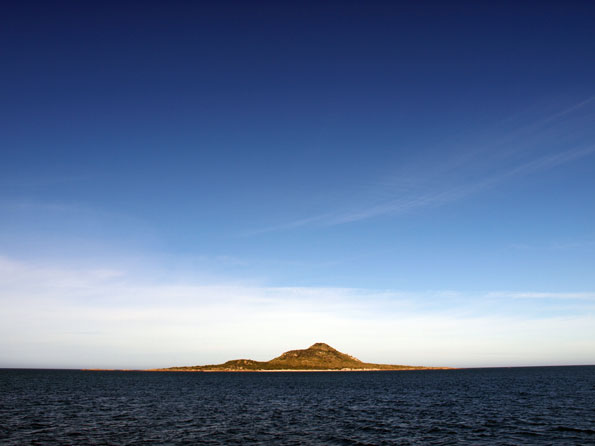Gentle reader, my apologies for the lack of “blog” for the past few days. The weather has seen us holed up at Deal Island where there has been no internet reception. I have been busy writing, but unable to publish, (a common problem in the creative pursuits).
It was Bob Dylan’s “outrageous” wind that blew all night, sweeping down the hills and raging across the bay. I look across to the island and notice a couple of moving dots on the beach, and in the scrub beyond I can just make out the slope of a roof. Someone has built a shack on Roydon Island.
There are shacks on many of the rocks and island throughout the Ferneaux Group, where people have luckily discovered their own piece of paradise. It was not always so. The first men to build shacks on the islands of Bass Strait were to come to be known as The Straitsmen. They were a motley mob of renegades, escaped convicts from the penal settlements of Van Diemens’s land and castaways. To survive they fished, and slaughtered seals, trading the skins to passing ships. They shunned outside attention for obvious reasons. A few strong men, with colourful names like Mauritian Jack and Long Tom established small feudal societies, but the majority were loners. They would form raiding parties and sail to the mainland or Tasmania to kidnap Aboriginal women to help slaughter their seals, clean their fish and satisfy other more basic urges. The hard reputation these men enjoyed saved them from the gallows, for King George’s navy diverted its eyes. As long as these wild men controlled the islands of Bass Strait, other foreign powers, namely the French, would be deterred from claiming them.
This proved an astute decision on one occasion when the Straitsmen fought a pitched battle against a fleet of whalers from Nantucket, who had discovered the rich bounty the strait had to offer. The ferocity of the assault sent the Americans packing, and they retreated to the waters off Western Australia, where the locals were a little less hostile.
Here at Roydon Island, the modern Straitsmen appear to be engaged in less desperate pursuits. An aluminium dingy is bobbing on the water. Four sea kayaks appear around the head, and a solitary power boat can be seen pushing a wake across Marshall Bay. Skipper has decided to wait and see if the wind abates a little before attempting the crossing to Deal Island. At present it is blowing from the north at around 20 knots, we would be sailing straight into it. I use the down time to work on the Diamantina website, and at around 2.30 Robert calls us to make ready to sail. Fifteen minutes later, cabin secured, gas off, lee cloths up and anchor stowed we are motoring around Roydon Island. I set the course to 310 degrees. Our passage to Deal Island is 35 nautical miles. We hoist the main and unfurl the headsail, and Escapade settles onto a gentle heel. The sea state is nowhere near as rough as we had expected, it is most pleasant sailing. Whilst we are making around 5 knots, our speed over ground is only 3.5, as we are under the influence of a tidal current surging around the top of Flinders Island. Whilst this is pushing us to the east, what we loose now we will gain later, as the tide is about to flood, and the current closer to Deal will run in the opposite direction.
It is a tight thing. It is now five o’clock and we still have eighteen nautical miles to sail, which will have us arriving at Deal right on sunset. Robert trims the sails for maximum speed. The wind has swung slightly to the east in our favour, and the swell has picked up a little. We are now making six and a half knots. Life is good.
The mountains of Flinders Island gradually fade into the blue afternoon mist and the cliffs of Deal Island rise before us, we can now just make out the lighthouse.
The wind is picking up, the light waning, and as we close on the island we encounter a strong easterly current. I twice adjust the course accordingly. We furl the headsail and come up into the wind and lower the main at the entrance to Murray Pass, the narrow strait that separates Deal Island from Dover and Erith Islands. It is a violent stretch of water. The tide runs back and forth at five knots, and the high cliffs loom menacingly on both shores, drawing the wind in and accelerating it twofold. Strong wind against tide creates standing waves. In here, standing waves are said to rise to a whopping six meters! We motor away from the tidal stream and into the sheltered waters of East Cove. In the last light I can just make out tiny heads bobbing in the water, mobs of little penguin coming home to shore after a days fishing. There is one other yacht moored in the bay. We drop anchor amid the cacophony of sea birds settling themselves for the night. Robert cooks pasta for dinner and immediately after I hit the quarterberth. Goodnight, sweet dreams, the world is well…


